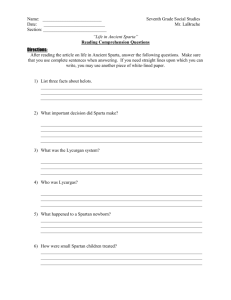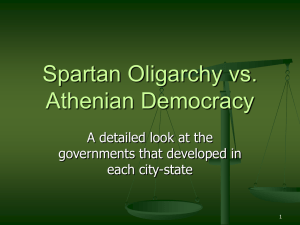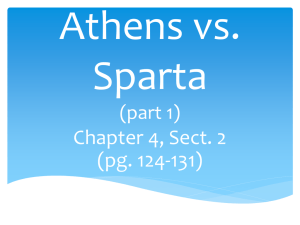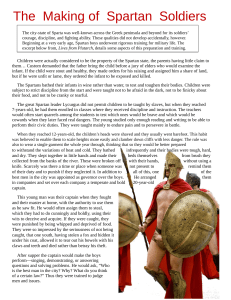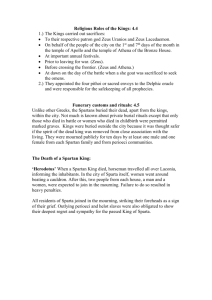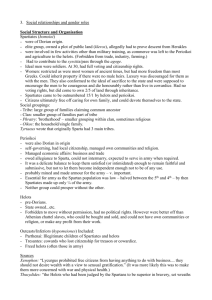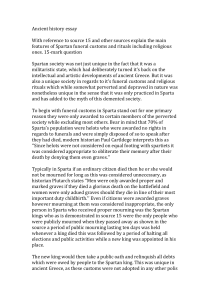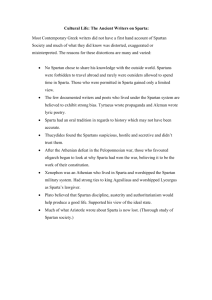Women in Sparta
advertisement
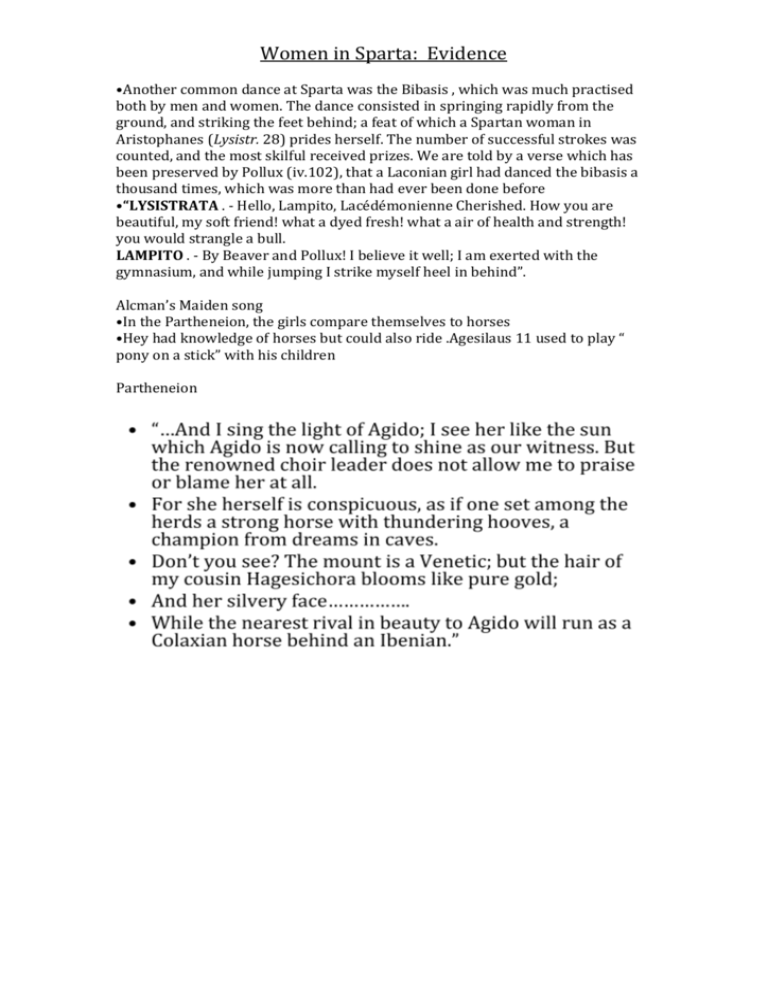
Women in Sparta: Evidence •Another common dance at Sparta was the Bibasis , which was much practised both by men and women. The dance consisted in springing rapidly from the ground, and striking the feet behind; a feat of which a Spartan woman in Aristophanes (Lysistr. 28) prides herself. The number of successful strokes was counted, and the most skilful received prizes. We are told by a verse which has been preserved by Pollux (iv.102), that a Laconian girl had danced the bibasis a thousand times, which was more than had ever been done before •“LYSISTRATA . - Hello, Lampito, Lacédémonienne Cherished. How you are beautiful, my soft friend! what a dyed fresh! what a air of health and strength! you would strangle a bull. LAMPITO . - By Beaver and Pollux! I believe it well; I am exerted with the gymnasium, and while jumping I strike myself heel in behind”. Alcman’s Maiden song •In the Partheneion, the girls compare themselves to horses •Hey had knowledge of horses but could also ride .Agesilaus 11 used to play “ pony on a stick” with his children Partheneion Images of Spartan Women Eugenic controls •“ His bride at the same time was scheming and helping to plan how they might meet each other unobserved at a suitable time….Such intercourse was not only an exercise in self control and moderation but also meant that partners were fertile physically, always fresh for love and ready for intercourse rather than being satiated and impotent from unlimited sexual activity.” •“On the other hand, if a man did not want to have intercourse with his wife but wanted children of whom he could be proud, he made it legal for him to choose a woman who was the mother of a fine family…and if he persuaded her husband, he produced children with her” Xenophon •Xenophon, Polybius, Plutarch and Nicolaus of Damascus all refer to polyandry at Sparta. Some scholars interpret “synoikein” as marry rather than in its common sense of cohabitate or have intercourse. Xenophon’s description of husband doubling postdates the Peloponnesian War and Leuctra indicating extreme circumstances requiring change Sayings of Spartan Women •“ When a woman was burying her son, a worthless old crone came up to her and said, “you poor woman , what a misfortune”. No by the two gods, a piece of good fortune because I bore him so that he might die for Sparta, and that is what has happened as I wished.” Community Involvement •Religion; In comparison with women of Athens,the activities of Spartan women included substantially more opportunities for racing and far less for weaving. Alcman’s poetry tells us of sumptuous banquets and the drinking of unmixed wine. Even when the rituals were enacted by women only they were considered an essential part of the religious life of all citizens. Votive offerings by women are evidence of close relationships with female divinities. •Although servile women did the routine weaving, freeborn women wove for ritual purposes. Pausanius reports that every year women wove a chiton for Apollo of Amyclae in a room designated as the chitona •Weaving instruments and plaques depicting textiles were discovered at the Shrine of Artemis Orthia. •Role as Priestesses. “The priestess, holding the xoanon, ( wooden image of Artemis ), stands by the Ephebes. It is usually light because it is very small; but if those who administer the whipping ever decrease the whipping because of the beauty or high status of the ephebe, then the xoanon becomes heavy for the woman and no longer easy to carry. She blames those who administer the whipping and says she is being weighed down because of them.” Pausanius Inheritance Laws- Change over Time •In terms of Greek law, an heiress was a fatherless, brotherless woman, known as “patrouchos”. •At the end of the 5th century the reforms of Epitadeus allowed women to inherit ‘kleroi” •In the absence of a male descendent, such a woman could be the means by which her father’s lineage was perpetuated. She might also transmit her father’s property to her son, or inherit it herself •Aristotle reports that at Sparta, heiresses were numerous. This was heightened in the 4th century by the problem of oliganthropia ( sparse male citizens )Aristotle complains that women owned as much as 2/5 of all Spartan land and attributed the downfall of Sparta to this element •In the later reforms of Agis 1V 244BC, he redistributed wealth to reinstate 600 landless citizens. Agis was able to convince his mother and grandmother, two of the wealthiest women in Sparta to donate their property Spartan Wives; Liberation or License •“ A modern feminist might perhaps approve their equal though separate education, which may have included an intellectual element; their frankness of utterance; their liberated attire; their freedom from sedentary and stultifying domestic chores; their control and management of households; their public valuation; and above all their property rights. On the other side, however, the modern feminist is unlikely to be over impressed by the way they were seized and had as wives in the domecile of their husbands, who could lend them for extra marital procreation….and finally and perhaps least of all by the overriding emphasis placed upon the woman’s child-bearing potential by men who monopolized the political direction of a peculiarly masculine society.” Paul Cartledge Using these sources and other evidence explain the role and contributions that Spartan women made to Sparta (12)
